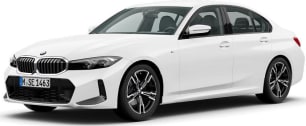The M4 Convertible is not a paragon of space efficiency, given its footprint.
At nearly 4.8 metres long and 1.9m wide, the M4 Convertible casts a sizeable shadow on the road, which only really pays dividends for front-seat occupants inside.
Ours was fitted with a very handsome pair of $7500, two-tone M Carbon bucket seats up front, a sort of futuristic tombstone design with a fixed headrest that looks like they were created by and for Stormtroopers; they do provide all the electronic adjustability one would need in terms of fore/aft, up/down and lumbar support movement.
But, unless you really need their g-force-bracing support and love their outrageous appearance, they are monumentally obstructive to effortless entry/egress and overall hip comfort if you don’t possess a gymnast’s physique. In fact, at times, they can feel downright torturous, especially in the gusset area due to the pointless (ironically) hard central bulge bit. The standard front seat set-up is perfectly fine, offering all the comfort and support expected in a luxury convertible, with the added bonus of headrest adjustability.
As with all G20/G80 generation 3/4 Series, the M4’s interior is a welcome return to form for BMW, from the excellent driving position and superb build quality, to thoughtful switchgear placement, brilliant ventilation and ample storage. And iDrive is probably the best and most intuitive multimedia system out there, too, needing no special skill or distraction once mastered.
A quick note about the instrumentation. The 4 Series design digital readouts are prettier than the standard 3 Series' ugly standard screen that looks ex-Honda Civic. This one offers alternative views and is easy to read at a glance. But it still makes us pine for good old analogue dials. Remember when BMWs were the world leaders in dial design?
Some familiarisation is also required to figure out the M part of the M4, including the various driving and performance modes; they’re divided into Road, Sport and Track settings. Yet, thankfully, they’re all far simpler to get your head round than before, which required too much fiddly concentration, since – once quickly learnt – everything is possible with eyes-on-the-road promptness. A new M Mode button offers pre-determined shortcuts to whichever drive combinations are desired.
The roof is well insulated, meaning that previous-gen folding hardtop-owning prospective buyers shouldn’t be too sad about the fabric above their heads. On the go, front occupants can enjoy a variety of configurations, starting with snug coupe-style cosiness and security, moving to cool pillarless hardtop-style windows-only down cruising, to the full top-down convertible glory. The latter also brings minimal buffeting at speed unless you’re stuck out in the back. Roof-up vision isn't brilliant, though.
Strangely, with the M Carbon bucket seat options ticked, it’s actually easier for some people to get into the back than the front. Pulling a strap sees the front bucket seats (slowly) whir as far forward as possible to allow sufficient room for people to clamber onto the rear seats.
Once sat, it’s clear that longer-legged people will struggle. Knee room is OK (especially if the front occupants are feeling sympathetic by moving their seats forward), there’s surprisingly adequate head room for your 178cm tester when slightly slouched, big feet can be tucked beneath the front seats and scalps never have to touch the rear glass thankfully.
And at least BMW has tried to make life back there comfier for smaller people, due to rear-facing air vents with climate and directional control, two USB-C ports, a pair of cupholders, a centre armrest and some handy storage. The materials are of a high quality construction, too.
However, the fixed back rest is far too upright, the knees-up posture quickly gets tiresome, the cushion is firm and you’re sat on a slight angle pointing outwards. Claustrophobics won't be too happy either. Annoyingly there aren’t side window buttons either, meaning only the driver can lower or raise them. The two-seater back seat is best saved for short trips or kids.
Happily, once the roof is dropped, the hemmed-in feel vanishes, there’s not too much wind intrusion or buffeting with the side windows up and there’s a sense of shared freedom that only a four-seater convertible can bring. Going the full drop-top experience will ruffle more than hairdos at freeway speeds, though. An optional wind deflector can fix that issue for front-seat occupants, but it goes over the back seats, turning the M4 into a two-seater ragtop.
Further back, the 300-litre boot isn’t accessible from the cabin, meaning you can’t put much inside at all. BMW fits a hinged flap that needs to be down for the roof to work since it cordons off the roof storage part of the boot when folded in; when lifted, there’s a useful amount of space for luggage, and it’s a handy rectangular shape instead of an L-shaped slot, but obviously at the cost of convertible driving. You can’t have both.
Note that, compared to the previous folding-hardtop M4, this boot is some 80L larger.

